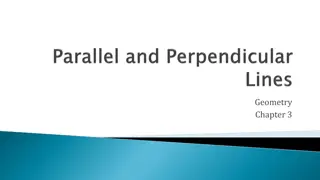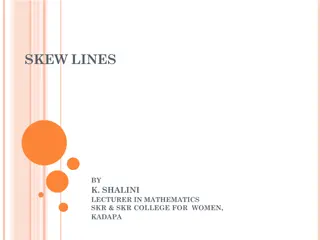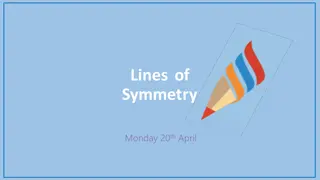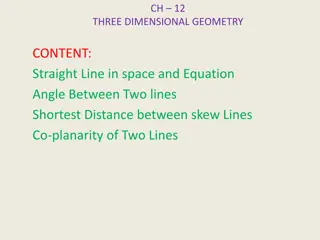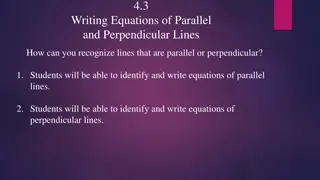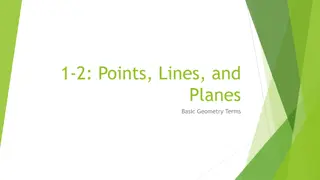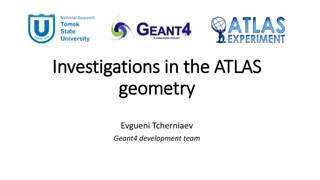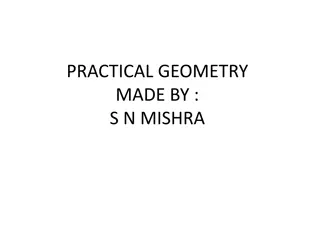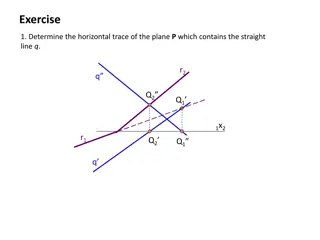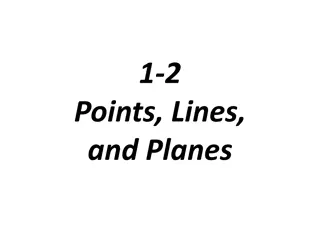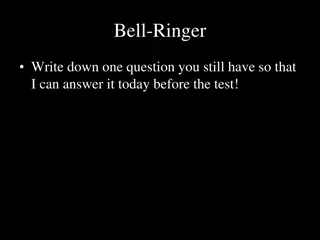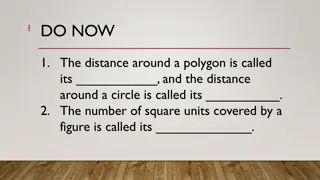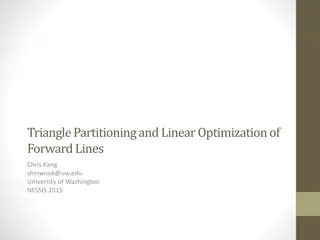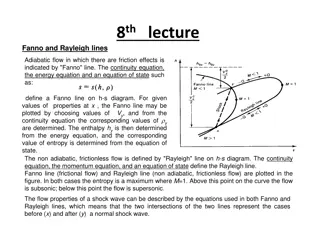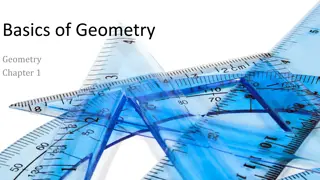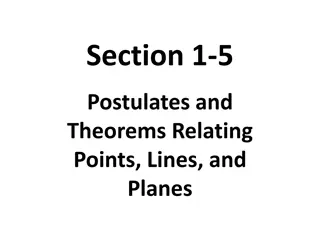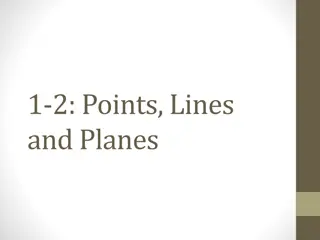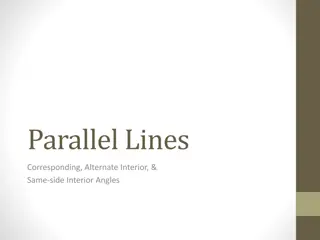Crossed Lines Geometry Exploration
This content delves into the concept of crossed lines in geometry, specifically examining the formation of right-angled triangles and the relationship between gradients. By utilizing Pythagoras' theorem and solving simultaneous equations, the properties and characteristics of intersecting lines are explored, leading to a deeper understanding of perpendicularity and geometry principles.
Download Presentation

Please find below an Image/Link to download the presentation.
The content on the website is provided AS IS for your information and personal use only. It may not be sold, licensed, or shared on other websites without obtaining consent from the author.If you encounter any issues during the download, it is possible that the publisher has removed the file from their server.
You are allowed to download the files provided on this website for personal or commercial use, subject to the condition that they are used lawfully. All files are the property of their respective owners.
The content on the website is provided AS IS for your information and personal use only. It may not be sold, licensed, or shared on other websites without obtaining consent from the author.
E N D
Presentation Transcript
Crossed Lines Don Steward
Crossed Lines Two lines: 2? + 4 = ? and ? + 2? = 8 ? meet at point ?. Show, by using Pythagoras' theorem, that the triangle formed by the lines and the ? ???? is right-angled.
Crossed Lines Solving the simultaneous equations yields the co-ordinates of point ?: ? + 2? = 8 2? + 4 = ? ? + 2? = 8 Re-writing (1) gives: 2? ? = 4 ? + 2? = 8 2? + 4? = 16 5? = 20 ? = 4 ? = 0 (1) (2) ? (1) (2) 4,0 2x(2) (3) (3)-(1) 2? + 4 = ?
Crossed Lines ? The co-ordinates of point ? are given by: 0,8 ? ? + 2 0 = 8 ? = 8 ? + 2? = 8 The co-ordinates of point ? are given by: ? 2? + 4 = 0 ? ? = 2 4,0 2? + 4 = ? ? 0, 2
Crossed Lines ? 0,8 We need to show that this triangle is right-angled. 4 80 If it is right-angled then: 8 2+ 2= 102 20 80 4,0 ? 10 Since this is true we can conclude that triangle ??? is a right-angled triangle. 2 20 4 0, 2 ? Is there a relationship between the gradients of the two lines you were given?
Crossed Lines Is there a relationship between the gradients of the two lines you were given? The equations: 2? + 4 = ? ? + 2? = 8 ? + 2? = 8 can be re-written as: ? =1 ? = 2? + 8 2? 2 The product of the gradients is 1. That is, 2? + 4 = ? 1 2 2 = 1. This is always true for perpendicular lines. Can you prove it?
Crossed Lines The gradient of line ?1 is: ? ?1=? ? The gradient of line ?2 is: ? ? ?2= ? ? ? Note the negative sign since the ?-value has decreased by an amount ?. So the product is: ?1 ?2 ? ? ? ? ?1 ?2= = 1 And this is independent of the values of ? and ?.
? ? Crossed Lines Crossed Lines Show, by using Pythagoras' theorem, that Show, by using Pythagoras' theorem, that the triangle formed by the lines and the the triangle formed by the lines and the ? ???? is right-angled. ? ???? is right-angled. ? + 2? = 4 2? + 2 = ? ? + 2? = 6 2? + 3 = ? meet at point ?. meet at point ?. Two lines: Two lines: SIC_25 SIC_25 and and
? ? Crossed Lines Crossed Lines Show, by using Pythagoras' theorem, that Show, by using Pythagoras' theorem, that the triangle formed by the lines and the the triangle formed by the lines and the ? ???? is right-angled. ? ???? is right-angled. ? + 2? = 10 ? + 2? = 8 2? + 4 = ? 2? + 5 = ? meet at point ?. meet at point ?. Two lines: Two lines: SIC_25 SIC_25 and and
? ? Crossed Lines Crossed Lines Show, by using Pythagoras' theorem, that Show, by using Pythagoras' theorem, that the triangle formed by the lines and the the triangle formed by the lines and the ? ???? is right-angled. ? ???? is right-angled. ? + 3? = 6 3? + 2 = ? ? + 3? = 9 3? + 3 = ? meet at point ?. meet at point ?. Two lines: Two lines: SIC_25 SIC_25 and and
? ? Crossed Lines Crossed Lines Show, by using Pythagoras' theorem, that Show, by using Pythagoras' theorem, that the triangle formed by the lines and the the triangle formed by the lines and the ? ???? is right-angled. ? ???? is right-angled. ? + 3? = 12 ? + 3? = 15 3? + 4 = ? 3? + 5 = ? meet at point ?. meet at point ?. Two lines: Two lines: SIC_25 SIC_25 and and
? ? Crossed Lines Crossed Lines Show, by using Pythagoras' theorem, that Show, by using Pythagoras' theorem, that the triangle formed by the lines and the the triangle formed by the lines and the ? ???? is right-angled. ? ???? is right-angled. ? + 4? = 12 ? + 4? = 8 4? + 2 = ? 4? + 3 = ? meet at point ?. meet at point ?. Two lines: Two lines: SIC_25 SIC_25 and and
? ? Crossed Lines Crossed Lines Show, by using Pythagoras' theorem, that Show, by using Pythagoras' theorem, that the triangle formed by the lines and the the triangle formed by the lines and the ? ???? is right-angled. ? ???? is right-angled. ? + 4? = 16 ? + 4? = 20 4? + 4 = ? 4? + 5 = ? meet at point ?. meet at point ?. Two lines: Two lines: SIC_25 SIC_25 and and
? ? Crossed Lines Crossed Lines Show, by using Pythagoras' theorem, that Show, by using Pythagoras' theorem, that the triangle formed by the lines and the the triangle formed by the lines and the ? ???? is right-angled. ? ???? is right-angled. ? + 5? = 10 ? + 5? = 15 5? + 2 = ? 5? + 3 = ? meet at point ?. meet at point ?. Two lines: Two lines: SIC_25 SIC_25 and and
? ? Crossed Lines Crossed Lines Show, by using Pythagoras' theorem, that Show, by using Pythagoras' theorem, that the triangle formed by the lines and the the triangle formed by the lines and the ? ???? is right-angled. ? ???? is right-angled. ? + 5? = 20 ? + 5? = 25 5? + 4 = ? 5? + 5 = ? meet at point ?. meet at point ?. Two lines: Two lines: SIC_25 SIC_25 and and


